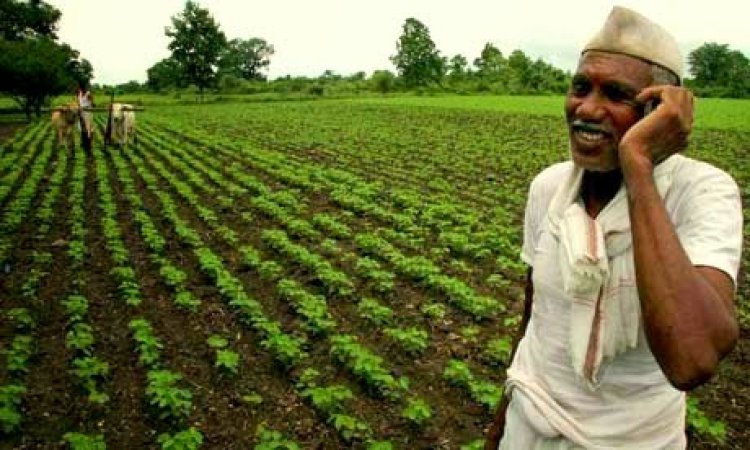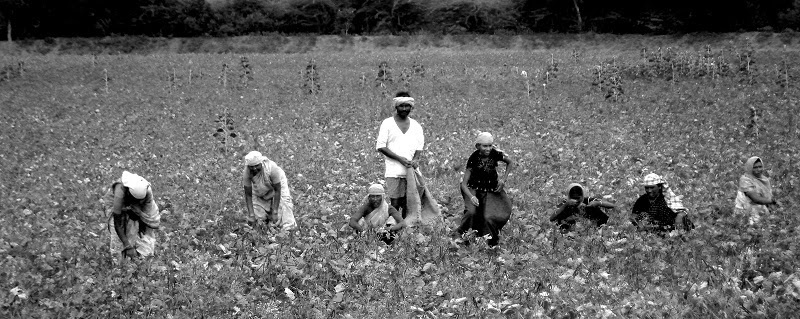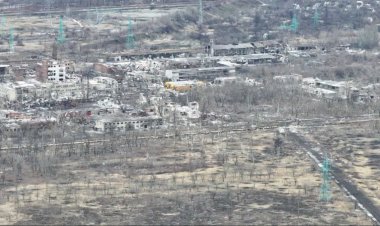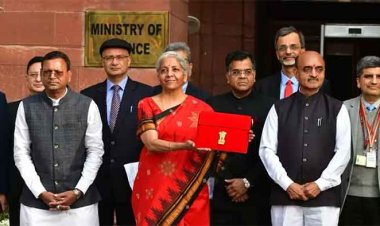|
| This article has been published in the Nov-Dec'13 issue of printed version of the magazine.The author of the piece is connected with Indian Statistical Institute, Kolkata |
The existing production relation in Indian agriculture, in no way, suggests a trend towards peasant capitalism. The various pre-capitalist classes along with landlords hinder both the process of proletarianization and formation of capitalist class from among the numerous middle and small peasants. The functioning of usurious capital and trading capital intertwined with imperialist capital sucks a significant part of surplus produced in small peasant economy basically keeping it perpetually in the stage of simple commodity production.
The pressure of ‘demographic development and economic stagnation’ might create favourable situation for progressive transformation of social production relation but these factors hardly, by themselves, cater fundamental changes in the nature of existing social production relation. Of course, during the last two decades there had been some quantitative changes regarding the number of people dependent on agriculture, commercialization of agricultural produce, importance of tenancy, but analysis of these features in the concrete condition shows that there is a semi-feudal rider behind all these.
So, still today, contradiction between feudalism and the broad masses remains one of the fundamental contradictions and solving this contradiction with the programme of land reform can only help establish progressive social production relation.
Fundamental not ‘principal’ is the proper term for analysis
The characterization of dominant production relation existing in Indian agriculture has been a subject of intense debate among many prominent writers for last four decades and now it is famously known as ‘Mode of Production debate’ (U. Patnaik 1990). Recently Amit Basola and Deepankar Basu (2011a) have taken another attempt to trace out the dominant aspect of relation of production in Indian society in their elaborate article entitled, “Relations of production and Modes of Surplus extraction in India”, Part 1 and Part 2 I EPW, April 2, 2011, using a large amount of recent data obtained by National Sample Survey Organization (NSSO). Apparently, after having established that the feudal relations are in the process of being marginalized, they put forward the following interesting questions,“If landlords, as a class, are dwindling in economic and social powers, is a programme aimed at breaking their political power still relevant? Is the contradiction between feudalism and the broad masses of the people still the principal contradiction in India today?” (Amit Basola and Deepankar Basu 2011b)
They reached the conclusion that the contradiction between feudalism and broad masses cannot be principal contradiction in the present day Indian society. The first point to be mentioned is that from the angle of Marxian political aspect, the question is not well formulated. One should keep in mind that even in a country with semi-feudal production relation as the dominant aspect, contradiction between imperialism and nation may be the principal contradiction at certain juncture. It happened in China in 1937 when it was attacked by Japan. Of course one may argue that contradiction between imperialism and nation does not exist in India. But most of the political parties that consider the contradiction between feudalism and broad masses to be principal also think that imperialism verses nation is one of the fundamental contradictions in Indian society with a possibility of its being elevated to principal contradiction at certain juncture. They think that these two contradictions are deeply related with each other in Indian society and determine the overall character and motion of the society.
So the proper question should be whether contradiction between feudalism and broad masses can be one of the fundamental contradictions in Indian society. Anyway, using various arguments the authors have come to the conclusion that present dominant feature of production relations in Indian agriculture is capitalistic and hence principal contradiction corresponds to contradiction between capital and labour. With this conclusion, naturally they have rejected redistributive land reform as one of the principal tasks of revolutionary reform of the Indian society (Amit Basola and Deepankar Basu 2011b).
Capitalism in Indian agriculture
Actually, there had been many attempts in the past to establish that social production relations in Indian agriculture are in the main capitalistic. But what is new in this article is that the authors have taken very recent NSSO data to make their point. Though they have discussed a large spectrum of production relations existing both in agriculture and in industry, we shall restrict our discussion and conclusion in the domain of agriculture. We shall try to show that their mode of explanation does not respect the criterion that exist in Marxist tradition, to decide whether capitalist relation is dominant or is in the process of replacing the pre-capitalist relations of production.
The main points that motivate the authors to come to this conclusion are the followings;
a) Declining power of landlords,
b) Increase of landlessness,
c) The declining importance of tenancy,
d) Main form of surplus extraction through wage labour.
Feudalism, unlike capitalism, represents a production relation which can take so many varied forms even in a single country. Specially, the caste system, nowhere found except in this subcontinent, provided and still provides strong basis for semi-feudal exploitation.
But whatever the forms it takes, the economic essence of feudalism is extraction of surplus through uneconomic means. Essentially it means that feudalism can be better understood by examining the absence of various capitalist features in the existing social production relation.
Capitalist relation means generalized commodity production where labour power itself becomes a commodity freely sold and bought in the market. But it is a class relation with two main classes, namely capitalists and proletariat, where capitalist class exploits the surplus value and reinvests a part of it as capital facilitating expanded reproduction. From this aspect, capitalism not only changes the mode of surplus extraction, a common feature of all class society, but it plays a progressive role in enhancing the productive power of the society. To quote Lenin,
‘The socialization of labour by capitalism is manifested in the following processes. Firstly, the very growth of commodity production destroys the scattered condition of small economic units that is characteristic of natural economy and draws together the small local markets into an enormous national (and then world) market. Production of oneself is transferred into production for the whole society….” (Lenin 1899)
This is the universal form of capitalism, though its initial appearance may occur in various ways. Specially, in the middle of Ninetieth Century, the capitalist class in various European countries abandoned the revolutionary path of uprooting feudal class and took a more compromising approach towards landlords in transforming them into capitalist farmers. This happened in German as well as in Russia. But any way, the ultimate destination was capitalist development in both the countries. Again there are some examples where capitalism in agriculture developed from below. It happened in US and in post 2nd world war Japan where small peasant economy gave birth to capitalist agriculture and for the later firm assistance of the government also played an important role.
If we accept authors’ statement regarding the decline of landlordism, then at least the Prussian path of development towards capitalism cannot be considered to be a feature of Indian agriculture. Again, if we consider the increasing tendency of small farms in India, the possibility of growth of capitalism in agriculture might emerge from the efficient small peasant economy and this is not an impossibility as witnessed in the past elsewhere. So if one has to establish that capitalist relation is emerging in Indian agriculture, then he has to show concretely how the small peasant economy is revolutionizing the production relation by destroying the hitherto existing predominant pre-capitalist relations and thereby deepening capitalist relation in Indian agrarian society. The transformation of social labour into a commodity, a basic feature of capitalism, is related to transformation of the structure of property relations. In agriculture it implies that land, the principal form of property itself has to be a commodity. In absence of this process, petty producers are not expropriated creating favourable situation for capitalist development. In order to establish capitalist development, one has to show the existence of this trend to be a prominent feature in Indian agriculture.
The authors, instead of doing this, somehow simply equate the landlessness and predominant scattered seasonal sell of labour by marginal, small and sometimes by middle farmers to the existence of free wage labour (in the capitalist sense) and came to the conclusion that “surplus extraction through the institution of wage labour has become one of the most important forms of extracting the surplus created by the direct producers.” (Amit Basola and Deepankar Basu 2011a)
But we would see how the authors, pained at the absence of agrarian capitalist class and also the process of expropriation of small and marginal farmers through the operation of market force, have tried to put the whole emphasis on the existence of exploitation of laboring people, a universal feature of class society, as characteristic feature of capitalism in Indian agriculture.
Weakness in the argument provided by Basole and Basu
Let us examine the weakness of the arguments provided by the authors in establishing capitalism in Indian agriculture. As the authors describes, the share of total area held by farmer families owning up to 2.5 acres has steadily increased from 8% of total area in 1961 to about 23% of total area owned in 2003. In the same period, the share of area owned by large landholding families reduced from 60% to 35%. Still though a significant amount of agricultural land are owned by large landholding families, the trend shows that it is declining.
The authors also described one of the striking features of contemporary Indian agriculture which is the predominance of small scale production. Hence if there is development of capitalism in Indian agriculture, the trend must be rooted in the small scale framing in India.
What are the features of small scale farming?
1) The half of the agricultural produce goes to the market.
2) The per acre yield in small farms are bigger than that for big farms.
3) Even small and marginal peasants employ wage labour.
There is no doubt that point (3) is characteristic of capitalism and (2) shows the possibility of capitalist development from below. But let us look through some other important features existing in Indian agriculture as pointed out by the authors themselves which, in no way, suggest the development towards capitalist relation;
(4) Vast majority of farmers are routinely hiring in as well as hiring out their labour power.
(5) 96% of the rural households had lower total income from cultivation, wage labour, farm animals and pretty production - than even what their extremely low expenditures
required.
(6) There have been explosion of debt over the last decade, leading in many cases to severe distress and even suicides. With the decline of institutional debt in agriculture, the credit must have come from the money lenders. This trend has intensified the drainage of agricultural surplus through usury.
The gravity of the situation can be understood from data provided in Aspects of India’s Economy (no.46, 2008). Using SASF (The Situation Assessment Survey Of Farmers) data (NSS Reports 495-499) along with some viable assumptions regarding non-institutional debt, it showed that in the year 2002-03, the interest payment in agriculture was around Rs 41,000 crore where the gross investment and net investment in agriculture were Rs 33,508 crore and Rs 7,874 crore respectively.
According to the authors, if predominant mode of surplus extraction seems to be working through institution of wage-labour, then where are the capitalists or would be capitalist in agriculture that would extract surplus value and reinvest it for expanded reproduction?
The author did not answer this question which could actually complete the circle in their argument in favour of capitalist development in Indian agriculture. In this context, a quotation from Ranjit Sau (1973) will be appropriate.
“Agricultural capitalism without capitalist farmer is as much nonsense as capitalism without the capitalist. And there is no basic difference between the capitalist in general and the capitalist farmer in particular.”
(a) First, the big land owing class (possessing over 10 hectares of land) invest only about 10.5% of the surplus they appropriate, in productive assets (This is all India average. The rate (22.3%) is somewhat higher in Punjab). Hence bulk of the surplus from this section does not return to productive investment.
(b) The data provided by the authors clearly show that most of the middle, small and marginal farmers cannot even earn their living from farming. So the question of acquiring surplus by them does not arise.
It is true that landless, middle, small and marginal farmers are creating surplus by their labour either through intense farming or labouring in other’s fields, but the bulk of the surplus is being appropriated by various classes who can hardly be recognized as capitalist class in Indian agriculture. The major part of surplus is appropriated by a complex combination of various unproductive exploiters. They are mainly usurers, traders and suppliers of agricultural equipments closely tied with the operation of imperialist capital. These ties have grown to be even stronger in the post globalization period. In those Indian states, where the agriculture has been more commercialized, there is more penetration of imperialist capital and along with it usury has also increased. That’s why most of the two and half million suicide deaths in last 15 years have occurred in those states where commercialization of agriculture is stronger. The share of crop sold in the market, varies from 69% to 81% in Andhra Pradesh, Karnataka, Punjab, Maharashtra, Kerala compared to average of 57% at all-India level and all these states recorded higher peasant suicide. All these exploiting classes mentioned above, may or may not have land.
So this is not at all peasant capitalism as suggested by the authors. This feature merely shows that most of the peasants are, in essence, involved in simple commodity production and that even happens in such a distress condition that continuous polarization among the peasantry through market competition cannot give rise to capitalism contrary to what happened in certain countries in pre-imperialist situation.
The authors, to make their point, put their emphasis only on the landlord class as the sole agent of semi-feudalism. But the term ‘semi-feudalism’ itself means there had been some infusion of capital which gives rise to some capitalist features closely intertwined with feudal base. This so called capitalist relation that penetrates the Indian agriculture, could, at the same time, breed various pre-capitalist classes other than landlords hindering the actual development of productive force. This thing started in the colonial period itself.
The authors (2011a) themselves observed, “Petty commodity production is exploited mainly by merchant and usurious capital where the main form of surplus extraction is through the mechanism of unequal exchange and not through the institution of wage labour; unequal exchange is often facilitated and maintained through interlinked product, labour and credit markets.”
In the main, market is a feature of capitalism, but in the way, all these various markets are interlinked in Indian society as also emphasized by several economists (A.Bhaduri 1983,
K.Bharadwaj 1974), is a strong sign of semi-feudal relations which hinders the development of free wage labour and induces distress sale by poor peasants. This interlinked markets associated with various pre-capitalist exploiters neither enhance the process of proletariazation nor allow a section of the peasants to gradually become capitalist by natural polarization.
Aspects of India’s Economy (no.46, 2008) summarized this features in the following way; “….The peasantry is compulsively involved in production for the market, but is neither able to carry out accumulation nor able to exit an over-crowded agriculture. Given this helpless condition of the peasantry, the dominant agrarian classes, with control over land, credit and the market for inputs and produce, are able to extract surplus without re-deploying the surplus to expand productive forces. A cross-country traveler cannot help but observe how this surplus in the hands of the dominant agrarian classes is diverted to luxury consumption, usury, acquisition of land fragments, trading/hoarding/speculation, sundry business (for example, construction contracts, labour supply contracts, truck/bus transport, cinema theatres, hotels, engineering/medical colleges, marriage palaces), criminal activity, and the consolidation of social and economic power through expenditure on elections. Significantly, the surplus from agriculture in the hands of the dominant rural classes fails to get deployed in small-scale industry, which everywhere is visibly starved of funds.” (p.53)
So all these pre-capitalist parasitic class along with the existing landlord section, however dwindling they are, comprise the most reactionary feudal force that hinders the development of productive force in Indian agriculture.
Two points that the authors have over emphasized;
1) Declining power of landlords; Significant inequality has remained in land ownership as found by National Sample Survey (NSS Report no.491). The top 9.5% households own 56.6% of the total cultivable area. The remaining 90.5% households, which is such a large population, only own 43.4%.
2) Prevalence of wage labour in cultivation; In 2007-08 NSS report shows the share of wage labourers in the agricultural work force has declined and that of cultivators has increased; the share of cultivators is now 64.2% which is higher than that in 1983. As agricultural trade is working against the interest of peasants, the trend develops towards reduction of the cost by substituting family labour for hired labour.
Hence the wage labour, that the authors have repeatedly emphasized, is not free wage labour, a characteristic feature of capitalism, but mainly admixtures of various free, un-free and semibonded labours.
Recently Visav Bharati (2011) reported on the condition of agricultural labourers of Punjab which is considered as the citadel of capitalism in Indian agriculture. He revealed the fact that the suicide death of farmers in Punjab also includes a significant number of agricultural labourers. The vicious debt trap, created by landlords and shopkeepers, that affected the labourers, suggests that agricultural labourers may not be bonded in a classical sense, but they can hardly be considered to be free in the capitalistic sense.
Capitalist relation is a progressive social production relation compared to feudalism or semifeudalism. The authors have apparently followed Marxist framework in identifying various classes and production relation. But Marxist theory also teaches us that without intervention of social progressive force in the social and political arena of the country, who would act as agent of capitalist relation, capitalism cannot be established. ‘Sheer pressure of demographic development and economic stagnation’ may, of course, induce various changes within the overall semi-feudal structure, but can never cater the qualitative changes that are necessarily required for capitalist development.
International monopoly capital and capitalism in backward countries
Actually the various features, economists have described, as characteristics of capitalist
development in Indian agriculture could be shown to exist even in the colonial era. But when analyzing the mode of production in any underdeveloped country in today’s world, one should do it in the context of global imperialist system under which global monopoly capital is functioning. Two important points have to be kept in mind;
(1) Imperialist countries want preservation of pre-capitalist mode of production to perpetuate a system where land and labour are chief, capital is scarce, so that profitable investment of surplus capital (Lenin 1916) generated in the developed countries could be guaranteed. With this aim, the political strategy that is adopted by imperialist rulers, are the following as was expressed by Third International;
“Imperialism first of all allies itself with the ruling classes of the previous social structure, with the feudal lords and the trading and money-lending bourgeoisie, against the majority of the people. Everywhere imperialism attempts to preserve and perpetuate all those pre-capitalist forms of exploitation (especially in the villages) which serve as the basis for the existence of its reactionary allies.” (N. Sen Gupta, 1977)
(2) In the neo-colonial system of exploitation, monopoly capital cannot earn profits just by directly allying with pre-capitalist class and preserving all the forms of old mode of production which could have been possible in pre-imperialist colonial system as British rulers primarily did in India. For earning super profits they have to develop a system in backward countries which promotes certain level of capital investment, commercialization of agricultural outputs, development of market for land and labour and various institutions related to market.
At the same time, pre-capitalists classes in these countries also modify their mode of operation in a way that becomes consistent with this development.
This is what happened in India after British rulers left in 1947. Specially, after the implementation of US dictated programme of Green Revolution in certain selected areas in India, various economists found capital investment in agriculture, agricultural production for market, market for agricultural inputs etc to a large extent and no one can deny that all these are features of capitalism. But this is one part of the story.
Regarding the other part, N. Sen Gupta noted, “The other part is the prevalence of surviving feudal mode of production and feudal social formation – the semi-feudal aspects of the agrarian formations. The survival does not occur in pure forms. Instead, it occurs in an assimilated form, running over a variety of proportionality between feudal mode and capitalist mode, becoming sometimes as advanced as almost capitalist and sometimes as backward as only marginally altered form of the pre-capitalist (feudal) mode.” (N. Sen Gupta, 1977)
To understand the thing by a concrete example, we can consider the correlation between commercialization in agriculture and usury which made havoc for the peasants in recent time in our country. Due to some increase of institutional lending to farmers in the 1970’s and 80’s, the usury declined to some extent. But since 1990’s, under the pressure of neo-liberal dictated programme of reducing institutional debt and introducing vigorous commercialization in agriculture, the usury again has made a powerful comeback. Only the appearance, as also observed by the authors, was somewhat different with new kind of people taking part in usury. In various places, traders of agricultural produces, school-teachers, government servants etc. have involved themselves in this business. There had been found strong correlation among commercialization of agriculture, usury and peasant’s suicide death.
The authors (2011a) themselves observed, “While the share of total credit provided by the moneylenders declined substantially between 1961 and 1981, the trend of rapid decline was halted in the early 1980s. Since then the moneylenders had made a spectacular comeback in rural India……While the earlier brand of moneylenders had close links with landed property, the new crop does not seem to have that connection.”
The other important feature that should be noted is the decline of capital formation in agriculture due to reduction of public investment again at the behest of neo-liberal policy dictated by international monopoly capital.
As Debarshi Das (2010) concluded in his article at Sanhati (sanhati.com), “….With the inauguration of economic planning capital formation in agricultural sector started to improve. This was stimulated by large spending by the State. However public investment spending began to decline in absolute terms from 1980s which in turn affected growth of private and total investment. Rising population pressure on land combined with flagging investment resulted in the fragmentation of landholdings. Agricultural yield started to get affected from early nineties. Output growth has also stagnated in the last two decades.”
Land reform still remains a key to social progress in India
Regarding the question of land reform, the authors have tried to show how the programme for redistributive land reform would make the plots so small that it would be economically unviable specially, with the present cost of cultivation. Hence it will not generate any surplus that can help industrialization. At this point, the authors take a position which clearly undermines the programme of land distribution if not its complete denial.
Let us remember the following points;
(a) However small, surplus value is produced in agriculture with the abundant small peasant economy which fattens all the semi-feudal exploiters along with imperialist capital,
(b) Large land holdings in India are not superior in term of production.
So these immediately tell that redistributive land reform by appropriating the lands of non farmers cannot make the situation worse.
But the more important thing is that the revolutionary land reform also means uprooting all the existing feudal exploitation closely intertwined with imperialist exploitation which has further accentuated in the period of globalization. The present cost of cultivation is closely associated with the unequal market operation always working against the interest of farmers. Then how can it be true that redistributive land reform will not be viable in the absence of the fetters generated under the existing semi-feudal condition? At the same time the essence of land reform means breaking feudal ownership of land, not abolition of ownership in general. Even under proper leadership land can be distributed in a viable way.
The main thing of revolutionary land reform is not just everyone getting a piece of land, but emphasis should be shifted from the distribution of existing wealth, to forging conditions for the creation of new wealth on the grave of feudal structure.
The programme of land reform can only democratize the agrarian society without which genuine cooperation or collectivization will not be possible. The concrete experience of Chinese revolution clearly showed that post land reform economy really could generate the necessary capital for the industry as well as demand for the industrial product in contrast to the impression given by the authors. Interestingly, where the authors expressed their doubt regarding the progressive role of redistributive land reform by suggesting have a look into the concrete experience of both Russia and China in their EPW article, in their summary article published in Sanhati (2009), they have only mentioned about Russian revolution.
References:
Basole, A, and Basu, D (2011a) “Relation of Production and mode of surplus extraction in India: Part I - Agriculture”, Economic & Political Weekly, Vol. XLVI, No 14, pp 41-58.
Basole, A, and Basu, D(2011b) “Relation of Production and mode of surplus extraction in India: Part II - Informal Industry”, Economic & Political Weekly, Vol. XLVI, No 15, pp 63-79.
Basole, A and Basu, D(2009) “ Summary: Relation of Production and mode of surplus extraction in India” http:// Sanhati.com.
Bhaduri, A(1983) “The Economic Structure of Backward Agriculture”, Academic Press,
London.
Bharti, V (2011) “Indebtedness and Suicides: Field Notes on Agricultural Labourers of Punjab”, Economic & Political Weekly, Vol. XLVI, No 14, pp 35-40.
Bharadwaj, K(1974) “Production condition in Indian Agriculture – A Study Based on Farm Management Surveys”, Occasional Paper 33, Department of Applied Economics, Cambridge University Press, Cambridge.
Das, Debarshi (2010), “Some aspects of agricultural investments in India”, http:// Sanhati.com.
“India’s Runaway Growth”, Aspects of India’s Economy no.46, 2008.
Lenin, V.I. (1899) “The Development of Capitalism in Russia”, Collected works, Vol.3.
Lenin,V.I. (1916) “Imperialism, The Highest Stage of Capitalism”, Collected works, Vol.22, P 274.
Patnaik, Utsa (1990) “The Mode of Production'Debate in India”, Published for. Sameeksha Trust by. Oxford University Press, 1990.
Sen Gupta, N(1977) “Further on the Mode of Production in Agriculture”, Economic & Political Weekly, Vol. 12, No 26, pp A55 -A63.
Sau, Ranjit(1973) “On the Essence and Manifestation of Capitalism in Indian Agriculture”, Economic & Political Weekly, Vol.8, No 13, pp A27-A30.
















